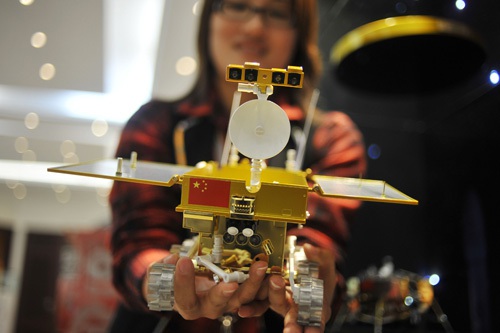|
 |
|
MARKET SHOW: A saleswoman in Dongguan, Guangdong Province, displays a model of China's lunar rover, Yutu, on December 4 (WU LU) |
Chang'e-1 transmitted back 1.37 terabytes of data, producing China's first complete imaging of the moon after orbiting it for 494 days. On November 12, 2008 China published the first lunar hologram with a resolution of 7 meters based on data collected by Chang'e-1.
The probe hard landed on the lunar surface on March 1, 2009 opening up a new age of space exploration for China.
Chang'e-2 tested some of the technology crucial to the Chang'e-3 mission and preformed reconnaissance of the landing area to be used by Chang'e-3, as well as taking what is potentially the highest resolution image of the lunar surface to date with a resolution of 7 meters.
Currently, Chang'e-2 is more than 60 million km away from the Earth and has become China's first man-made asteroid. It is currently heading toward deep space and is expected to travel as far as 300 million km away from Earth, the longest voyage of any Chinese spacecraft.
Space exploration
"Everyone knows fossil fuels such as gas and coal will be used up one day, but there are at least 1 million metric tons of helium-3 on the moon," said Ouyang Ziyuan, chief scientist of China's lunar program.
Helium-3 is considered by many scientists to be a nearly perfect energy source that could be used in nuclear fusion and has the potential to replace oil and gas, as it is non-polluting and has no radioactive byproducts. Helium-3 is very rare on Earth, but is believed to be more abundant on the moon.
"If mining the moon for helium-3 and obtaining nuclear power from it become reality, moon resources could be used to generate power for more than 10,000 years," Ouyang said.
Luan Enjie, another senior adviser to China's lunar program, said that China ultimately aims to use the moon as a "springboard" for deep space exploration.
"We've embarked in deep space exploration for 10 years, and we still have a long way to go," said Luan, former Director of the China National Space Administration. "Many of our scientists are studying Mars, and how Chinese astronauts could land on it."
Email us at: yuanyuan@bjreview.com
Timeline of China's Lunar Program
January 2004: The lunar program is formally established.
October 24, 2007: Chang'e-1 lunar probe is launched.
March 1, 2009: Chang'e-1 impacts the moon under control.
October 1, 2010: Chang'e-2 is sent into space.
April 1, 2011: Chang'e-2 completes its planned six engineering objectives and four scientific missions and its design lifetime expires.
August 25, 2011: Chang'e-2 arrives in second Lagrange Point orbit, which is 1.5 million km from the Earth and where gravity from the sun and Earth balances orbital motion, allowing for an additional deep space exploration mission.
December 13, 2012: Chang'e-2 arrives in deep space 7 million km away from the Earth, and surveys the Tout asteroid.
December 2, 2013: Chang'e-3 is launched. | 